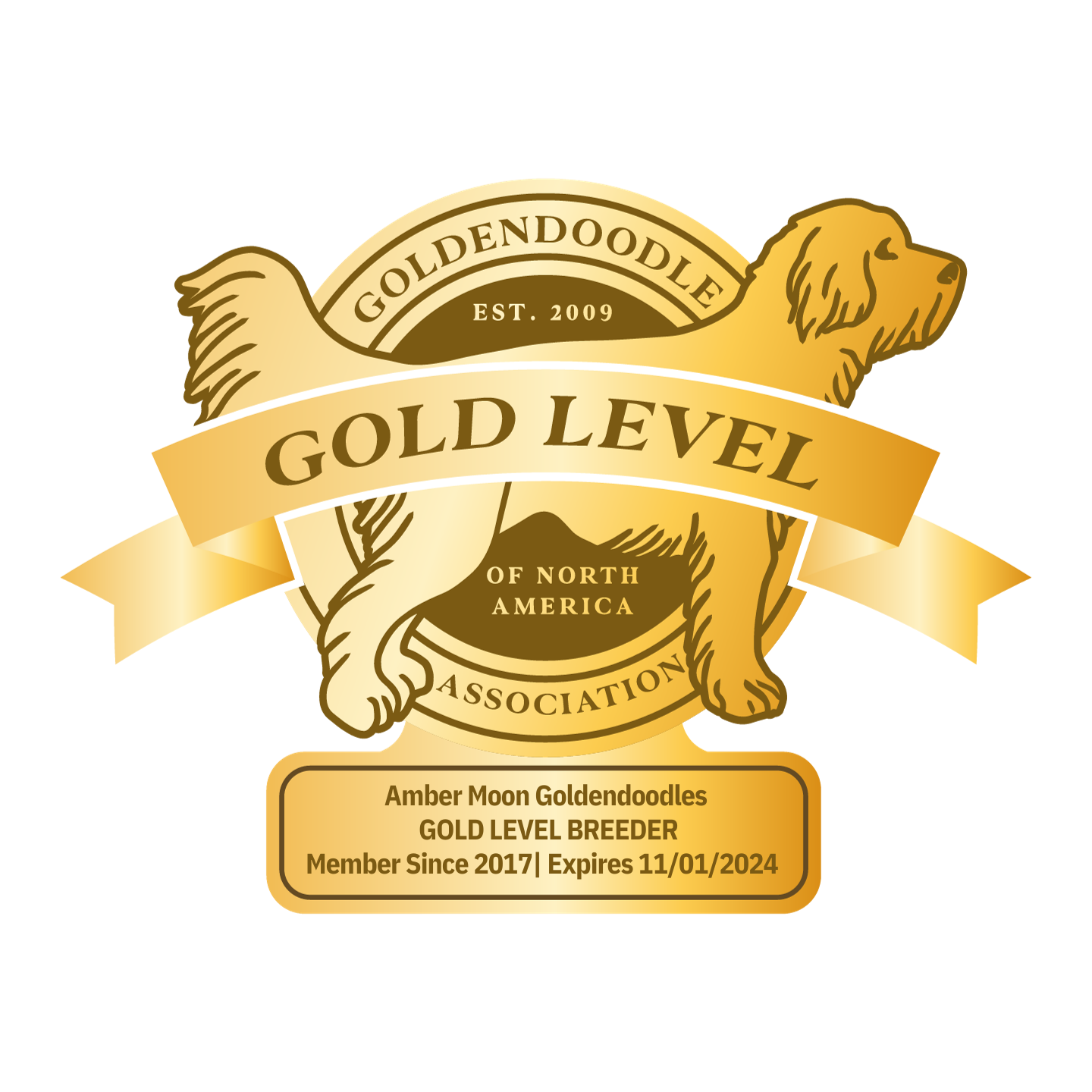G.A.N.A.
G.A.N.A. stands for Goldendoodle Association of North America. The organization supports responsible breeding and pet ownership. G.A.N.A. breeders are bound by a code of Ethics, they must subject all breeding dogs to comprehensive health testing requirements before any puppies can be born, and there are several breeder policies and guidelines that a breeder must adhere to.
We are proud to be a blue ribbon member of this organization, it means you will get a healthy puppy of the highest quality. Contact us with any questions you may have!
Please click on the logo below or visit G.A.N.A.'s website to find out more about this outstanding organization. Below is a list of the health testing requirements of a blue ribbon status breeder.
Below is a list of tests our dogs have been subjected to, and all are clear or 'clear by parentage'. Clear by parentage means a dog from fully tested and cleared parents, the parentage verified by DNA testing and certified by Pawprint Genetics, our testing lab. You will receive a copy of the parents of pup's test results, or a copy of the parentage certification and test results.
1 - Degenerative Myelopathy (DM) This is an adult-onset spinal cord disorder. It is a degeneration of the 'white matter' of the spinal cord and peripheral nerves.
2 - Dystrophic Epidermolysis Bullosa This is a hereditary skin disease. Affected dogs have fragile skin that is easily damaged from rubbing or trauma resulting in blisters, ulcers and scarring of the skin.
3 - GM2 Gangliosidosis (Poodle Type) This is a congenital lysosomal disorder affecting poodles, and is a progressive neurodegenerative disorder with a fatal outcome.
4 - Ichthyosis (Golden Retriever Type) This is an inherited condition of the skin affecting golden retrievers. The age of onset and severity of disease are highly variable, however most affected dogs present before one year of age with flaky skin and dull hair.
5 - Muscular Dystrophy (Golden Retriever Type) This is an inherited disease affecting Golden Retrievers. Affected dogs are unable to produce adequate amounts of a protein important for muscle contraction and relaxation. Affected dogs may also suffer from aspiration pneumonia and cardiac disease.
6 - Neonatal Encephalopathy with Seizures This is an inherited disease of the brain that becomes apparent soon after the pups are born. Affected pups are small, weak, uncoordinated, and mentally dull from birth. None have survived to 7 weeks of age.
7 - Osteochondrodysplasia This is a general term for a disorder of the development (dysplasia) of bone ("osteo") and cartilage ("chondro"). Luckily it is a rare disorder.
8 - Osteogenesis imperfecta (Golden Retriever Type) This is an inherited Collagen disorder affecting dogs. Affected dogs typically present between 3 to 4 weeks of age with pain, lameness and fractures. Other features of the disorder include loose joints and brittle teeth.
9 - Progressive Retinal Atrophy, Golden Retriever 1 This is a late-onset inherited eye disease affecting dogs. Affected dogs begin showing clinical symptoms related to retinal degeneration between 6 to 7 years of age. Affected dogs initially have vision loss in dim light (night blindness) and loss of peripheral vision, eventually progressing to complete blindness in most affected dogs.
10 - Progressive Retinal Atrophy, Golden Retriever 2 This is an inherited eye disease affecting dogs. Affected dogs begin showing clinical symptoms related to retinal degeneration between 4 to 5 years of age. Affected dogs initially have vision loss in dim light (night blindness) and loss of peripheral vision, eventually progressing to complete blindness in most affected dogs.
11 - Progressive Retinal Atrophy, Progressive Rod-Cone Degeneration PRA-prcd occurs as a result of degeneration of both rod and cone type Photoreceptor Cells of the Retina, which are important for vision in dim and bright light, respectively. Degeneration of both rod and cone photoreceptor cells of affected dogs usually occurs 3 to 5 years of age or later.
12 - Sensory Ataxic Neuropathy This is an inherited neurologic condition affecting Golden Retrievers. Affected dogs typically present between 2 to 8 months of age with signs of neurologic disease. Symptoms include a lack of muscle coordination, abnormal gait and difficulty balancing especially affecting the hind limbs.
13 - Von Willebrands Disease This is the most common inherited blood clotting disorder in dogs. It is the result of an insufficient amount of von Willebrand factor (vWF), which is a plasma protein that helps blood to clot. vWD can result in excessive, serious bleeding from even a minor skin wound.
Our dogs have been tested and X-rays of hips and elbows have been forwarded to the Orthopedic Foundation of Animals, and they have been verified by OFA veterinarians and the results have been normal, and/or good or excellent. Also of a copy these tests will be included in your puppy packet.
Last but not least, our dogs have been entered in CAER (Companion Animal Eye Registry) an eye test done by a board certified veterinary ophthalmologist to make sure you will get a healthy dog. You will be also provided with a copy of these results.
